Oppidum
An oppidum (plural oppida) is a large fortified Iron Age settlement or town. Oppida are primarily associated with the Celtic late La Tène culture, emerging during the 2nd and 1st centuries BC, spread across Europe, stretching from Britain and Iberia in the west to the edge of the Hungarian plain in the east.[1][2][3][4][5][6] These settlements continued to be used until the Romans conquered Southern and Western Europe. Many subsequently became Roman-era towns and cities, whilst others were abandoned.[7][8][9] In regions north of the rivers Danube and Rhine, such as most of Germania, where the populations remained independent from Rome, oppida continued to be used into the 1st century AD.
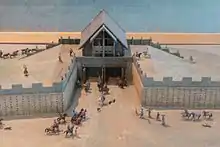 | |
| Location | France, Germany, Italy, Britain, Spain, Portugal, Austria, Belgium, Czech Republic, Switzerland, Slovakia, Serbia, Hungary |
|---|---|
| History | |
| Cultures | Celts, La Tène culture, Ancient Rome |
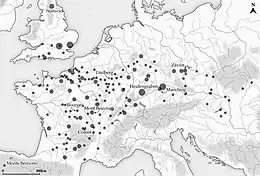
Definition
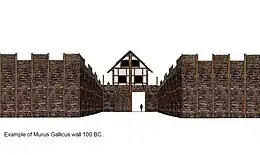
Oppidum is a Latin word meaning 'defended (fortified) administrative centre or town', originally used in reference to non-Roman towns as well as provincial towns under Roman control.[10][11] The word is derived from the earlier Latin ob-pedum, 'enclosed space', possibly from the Proto-Indo-European *pedóm-, 'occupied space' or 'footprint'. In modern archaeological usage oppidum is a conventional term for large fortified settlements associated with the Celtic La Tène culture.[12]
In his Commentarii de Bello Gallico, Julius Caesar described the larger Celtic Iron Age settlements he encountered in Gaul during the Gallic Wars in 58 to 52 BC as oppida. Although he did not explicitly define what features qualified a settlement to be called an oppidum, the main requirements emerge.[13] They were important economic sites, places where goods were produced, stored and traded, and sometimes Roman merchants had settled and the Roman legions could obtain supplies. They were also political centres, the seat of authorities who made decisions that affected large numbers of people, such as the appointment of Vercingetorix as head of the Gallic revolt in 52 BC.[14]: 12–13
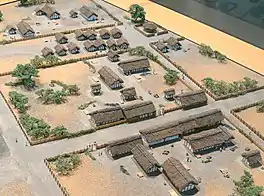
Caesar named 28 oppida. By 2011, only 21 of these had been positively identified by historians and archaeologists: either there was a traceable similarity between the Latin and the modern name of the locality (e.g. Civitas Aurelianorum-Orléans), or excavations had provided the necessary evidence (e.g. Alesia). Most of the places that Caesar called oppida were city-sized fortified settlements. However, Geneva, for example, was referred to as an oppidum, but no fortifications dating to this period have yet been discovered there. Caesar also refers to 20 oppida of the Bituriges and 12 of the Helvetii, twice the number of fortified settlements of these groups known today. That implies that Caesar likely counted some unfortified settlements as oppida. A similar ambiguity is in evidence in writing by the Roman historian Livy, who also used the word for both fortified and unfortified settlements.[14]: 13
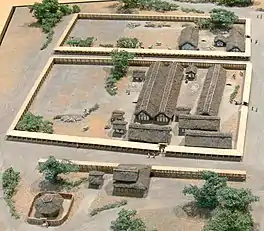
In his work Geographia, Ptolemy listed the coordinates of many Celtic settlements. However, research has shown many of the localisations of Ptolemy to be erroneous, making the identification of any modern location with the names he listed highly uncertain and speculative. An exception to that is the oppidum of Brenodurum at Bern, which was confirmed by an archaeological discovery.[14]: 13
In archaeology and prehistory, the term oppida now refers to a category of settlement; it was first used in that sense by Paul Reinecke, Joseph Déchelette and Wolfgang Dehn in reference to Bibracte, Manching, and Závist.[15][16] In particular, Dehn suggested defining an oppidum by four criteria:
- Size: The settlement has to have a minimum size, defined by Dehn as 30 hectares (74 acres).
- Topography: Most oppida are situated on heights, but some are located on flat areas of land.
- Fortification: The settlement is surrounded by a (ideally uninterrupted) wall, usually consisting of three elements: a facade of stone, a wooden construction and an earthen rampart at the back. Gates are usually pincer gates.
- Chronology: The settlement dates from the late Iron Age: the last two centuries BC.[14]: 12
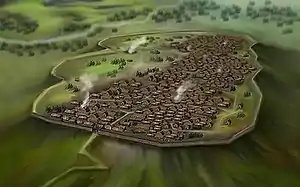
In current usage, most definitions of oppida emphasise the presence of fortifications, so they are different from undefended farms or settlements, and urban characteristics, marking them as separate from hill forts. They are often described as 'the first cities north of the Alps', though earlier examples of urbanism in temperate Europe are also known.[18][19] The period of 2nd and 1st centuries BC places them in the period known as La Tène. A notional minimum size of 15 to 25 hectares (37 to 62 acres) has often been suggested, but that is flexible and fortified sites as small as 2 hectares (4.9 acres) have been described as oppida. However, the term is not always rigorously used, and it has been used to refer to any hill fort or circular rampart dating from the La Tène period. One of the effects of the inconsistency in definitions is that it is uncertain how many oppida were built.[20]
In European archaeology, the term oppida is also used more widely to characterize any fortified prehistoric settlement. For example, significantly older hill-top structures like the one at Glauberg (6th or 5th century BC) have been called oppida.
Such wider use of the term is, for example, common in the Iberian archaeology; in the descriptions of the Castro culture it is commonly used to refer to the settlements going back to the 9th century BC. The Spanish word castro, also used in English, means 'a walled settlement' or 'hill fort', and this word is often used interchangeably with oppidum by archaeologists.[21]
Location and type

What was swept away in Northern Europe by the Roman Conquest was itself a dynamic indigenous culture extending across the transalpine landmass, usually known today as that of the Celts. The proto-urban Oppida – a Latin word used by Julius Caesar himself – remain one of the most striking manifestations of this pre-Roman northern European civilization.[22]
According to pre-historian John Collis oppida extend as far east as the Hungarian plain where other settlement types take over.[23] Around 200 oppida are known today.[24] Central Spain has sites similar to oppida, but while they share features such as size and defensive ramparts the interior was arranged differently.[25] Oppida feature a wide variety of internal structures, from continuous rows of dwellings (Bibracte) to more widely spaced individual estates (Manching). Some oppida had internal layouts resembling the insulae of Roman cities (Variscourt). Little is known, however, about the purpose of any public buildings.[14]: 28
The main features of the oppida are the walls and gates, the spacious layout, and usually a commanding view of the surrounding area. The major difference with earlier structures was their much larger size. Earlier hill forts were mostly just a few hectares in area, whilst oppida could encompass several dozen or even hundreds of hectares. They also played a role in displaying the power and wealth of the local inhabitants and as a line of demarcation between the town and the countryside.[14]: 25 According to Jane McIntosh, the "impressive ramparts with elaborate gateways ... were probably as much for show and for controlling the movement of people and goods as for defense".[26] Some of the oppida fortifications were built on an immense scale. Construction of the 7km-long murus gallicus at Manching required an estimated 6,900 m³ of stones for the façade alone, up to 7.5 tons of iron nails, 90,000 m³ of earth and stones for the fill between the posts and 100,000m³ of earth for the ramp. In terms of labour, some 2,000 people would have been needed for 250 days.[27] The 5.5km-long murus gallicus of Bibracte may have required 40–60 ha of mature oak woodland to be clear-felled for its construction.[28]
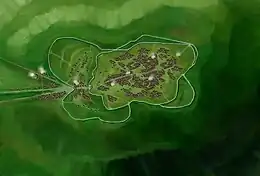
However, size and construction of oppida varied considerably. Typically oppida in Bohemia and Bavaria were much larger than those found in the north and west of France. Typically oppida in Britain are small, but there is a group of large oppida in the south east; though oppida are uncommon in northern Britain, Stanwick stands out as an unusual example as it covers 350 hectares (860 acres). Dry stone walls supported by a bank of earth, called Kelheim ramparts, were characteristic of oppida in central Europe. To the east, timbers were often used to support the earth and stone ramparts, called Pfostenschlitzmauer (post slot wall) or "Preist-type wall".[14]: 25 In western Europe, especially Gaul, the murus gallicus (a timber frame nailed together, with a stone facade and earth/stone fill), was the dominant form of rampart construction. Dump ramparts, that is earth unsupported by timber, were common in Britain and were later adopted in France.[29] They have been found in particular in the north-west and central regions of France and were combined with wide moats ("Type Fécamp").[14]: 25 Oppida can be divided into two broad groups, those around the Mediterranean coast and those further inland. The latter group were larger, more varied, and spaced further apart.[30]
In Britain the oppidum of Camulodunon (modern Colchester, built between the 1st century BC and the 1st century AD), tribal capital of the Trinovantes and at times the Catuvellauni, made use of natural defences enhanced with earthworks to protect itself.[31] The site was protected by two rivers on three of its sides, with the River Colne bounding the site to the north and east, and the Roman River forming the southern boundary; the extensive bank and ditch earthworks topped with palisades were constructed to close off the open western gap between these two river valleys.[31][32] These earthworks are considered the most extensive of their kind in Britain,[31][33] and together with the two rivers enclosed the high status farmsteads, burial grounds, religious sites, industrial areas, river port and coin mint of the Trinovantes.[31][34][35]
History
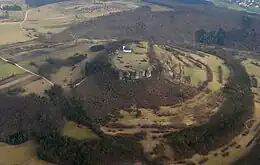
Prehistoric Europe saw a growing population. According to Jane McIntosh, in about 5,000 BC during the Neolithic between 2 million and 5 million people lived in Europe;[37] in the late (pre-Roman) Iron Age (2nd and 1st centuries BC) it had an estimated population of around 15 to 30 million.[37] Outside Greece and Italy, which were more densely populated, the vast majority of settlements in the Iron Age were small, with perhaps no more than 50 inhabitants. While hill forts could accommodate up to 1,000 people, oppida in the late Iron Age could reach as large as 10,000 inhabitants.[37]

Oppida originated in the 2nd and 1st centuries BC. Most were built on fresh sites, usually on an elevated position. Such a location would have allowed the settlement to dominate nearby trade routes and may also have been important as a symbol of control of the area.[26] For instance at the oppidum of Ulaca in Spain the height of the ramparts is not uniform: those overlooking the valley are considerably higher than those facing towards the mountains in the area. The traditional explanation is that the smaller ramparts were unfinished because the region was invaded by the Romans; however, archaeologist John Collis dismisses this explanation because the inhabitants managed to build a second rampart extending the site by 20 hectares (49 acres) to cover an area of 80 hectares (200 acres). Instead he believes the role of the ramparts as a status symbol may have been more important than their defensive qualities.[40]
While some oppida grew from hill forts, by no means all of them had significant defensive functions. The development of oppida was a milestone in the urbanisation of the continent as they were among the first large settlements north of the Alps that could genuinely be described as towns or cities (earlier sites include the 'Princely Seats' of the Hallstatt period).[14]: 29 Caesar pointed out that each tribe of Gaul would have several oppida but that they were not all of equal importance, implying a form of settlement hierarchy, with some oppida serving as regional capitals. This is also reflected in the archaeological evidence. According to Fichtl (2018), in the first century BC Gaul was divided into around sixty civitates (the term used by Caesar) or 'autonomous city-states', which were mostly organized around one or more oppida. In some cases, "one of these can be regarded effectively as a capital."[41][42]
Oppida continued in use until the Romans began conquering Iron Age Europe. Even in the lands north of the River Danube that remained unconquered by the Romans, oppida were abandoned by the late 1st century AD.[26] In conquered lands, the Romans used the infrastructure of the oppida to administer the empire, and many became full Roman towns. This often involved a change of location from the hilltop into the plain.
Examples
By modern country.
Belgium/Luxembourg/Netherlands
Czech Republic
France
Germany
Great Britain
Hungary
PortugalSerbiaSlovakiaSpain Monumental gate, walls, and paved streets, in the oppidum of San Cibrao de Lás.
Switzerland
|
See also
References
Notes
- "Oppida". oppida.org. 2000.
Oppidum (plural oppida) was the name used by Caesar to describe the Celtic towns that he discovered during his conquest of Gaul. In archaeology, the term is now used to describe all fortified Celtic sites covering a minimum area of 15ha and dating back to the second half of the 2nd and 1st centuries BC (the late La Tène period). These towns were both economic and political centres.
- "Oppidum". The Concise Oxford Dictionary of Archaeology.
Oppidum: The term used by Julius Caesar to describe fortified tribal centres encountered by him in Gaul in 58–51 bc which did not merit categorization as cities (urbes). In archaeological usage it is applied more generally to fortified sites and large permanent settlements of the late pre‐Roman Iron Age in Europe. These served as centres for administration, trade, craft production, and religion.
- Shaw, Ian; Jameson, Robert, eds. (1999). A Dictionary of Archaeology. Blackwell Publishing. p. 448. ISBN 0631174230.
Oppidum (pl. oppida; Latin: 'defended administrative centre or town'): During the later La Tene period in Gaul, from the 2nd century BC, there developed a series of large regional centres, some of which Julius Caesar in his reports of campaigns in the region, referred to as 'oppida' – a label that has stuck. Many of these oppida were defended, but unlike earlier hillforts of the 2nd and early 1st millennium BC, most seem to have been permanently and densely occupied. The more complex examples seem to have acted as tribal capitals, trade and distribution centres, and are often located near significant trade routes.
- Bahn, Paul, ed. (1993). Collins Dictionary of Archaeology. ABC-CLIO. p. 369. ISBN 0874367441.
Oppidum: A term used by Caesar to denote the fortified native towns he encountered in his campaigns in Gaul in 58-51 BC, now by extension used for all fortified Celtic towns; they are distinguished from hillforts by their combination of residential, industrial, market and administrative functions.
- Collis, John (1995). "The first towns". In Green, Miranda (ed.). The Celtic World. Routledge. pp. 159–173. ISBN 9781135632434.
By the time Caesar reached Gaul, the predecessors of Roman and modern towns were already in existence as administrative and trading centres ... Over a broad zone, Portugal, central Spain, southern Britain, France, southern and central Germany, the Alpine zone, Hungary and Czechoslovakia major settlements, often labelled by ancient authors and modern archaeologists alike as 'oppida', had come into existence.
- Fichtl, Stephan (March 2018). "Urbanization and Oppida". In Haslegrove, Colin; Rebay-Salisbury, Katharina; Wells, Peter (eds.). The Oxford Handbook of the European Iron Age. doi:10.1093/oxfordhb/9780199696826.013.13. ISBN 978-0-19-969682-6.
The first examples of urbanization in Celtic Europe were the princely residences of the early Iron Age (Hallstatt culture), but it was not until the late third century BC that urban centres began to flourish across Europe. The first were open settlements, followed by fortified oppida. Characterized by very large surface areas (up to hundreds of hectares) and defended by ramparts with strong symbolic and ostentatious connotations, oppida are widely considered the first cities north of the Alps. ... These fortified sites appeared more or less simultaneously in Europe, from the Atlantic to central Europe. By the last third of the second century BC, this wide area was covered with large-scale fortified sites.
- Collis, John (1995). "The first towns". In Green, Miranda (ed.). The Celtic World. Routledge. pp. 159–173. ISBN 9781135632434.
By the time Caesar reached Gaul, the predecessors of Roman and modern towns were already in existence as administrative and trading centres – Vesontio (Besancon), Durocororum (Reims), Lutetia (Paris), Avaricum (Bourges) and others. ... many major settlements were already well established by the time of the Roman conquest.
- Fernández-Götz, Manuel (December 2019). "A World of 200 Oppida: Pre-Roman Urbanism in Temperate Europe Oppida". In de Ligt, Luuk; Bintliff, John (eds.). Regional Urban Systems in the Roman World, 150 BCE – 250 CE. Brill. pp. 35–66. ISBN 978-90-04-41436-5.
Oppida, particularly in Gaul, continued to exist during the Roman period and sometimes even in medieval and later times (e.g. Vesontio→Besançon, Avaricum→Bourges, Durocortorum →Reims).
- Collis, John (2004). "Oppida". In Bogucki, Peter; Crabtree, Pam (eds.). Ancient Europe, 8000 B.C.-A.D. 1000. Gale. p. 157. ISBN 0-684-80668-1.
The oppida of Britain date to the late first century B.C. and early first century A.D. ... Several developed into major Roman towns.
- Shaw, Ian; Jameson, Robert, eds. (1999). A Dictionary of Archaeology. Blackwell Publishing. p. 448. ISBN 0631174230.
Oppidum (pl. oppida; Latin: 'defended administrative centre or town'.
- Purcell, Nicholas (7 March 2016). "Oppidum". Oxford Research Encyclopedia of Classics. doi:10.1093/acrefore/9780199381135.013.4571. ISBN 978-0-19-938113-5.
Oppidum, 'town', principally a descriptive word for an urban nucleus
{{cite book}}:|website=ignored (help) - Purcell, Nicholas (7 March 2016). "Oppidum". Oxford Research Encyclopedia of Classics. doi:10.1093/acrefore/9780199381135.013.4571. ISBN 978-0-19-938113-5.
In modern archaeological usage, oppidum has become a conventional label for the pre-Roman defensive enceintes of the iron age peoples of north-west Europe, especially the La Tène cultures (see celts).
{{cite book}}:|website=ignored (help) - "Ancient Europe 800 B.C-A.D 100" (PDF). Archived from the original (PDF) on 9 January 2016. Retrieved 9 November 2018.
- Rieckhoff, Sabine; Fichtl, Stephan (2011). Keltenstädte aus der Luft/AID Sonderheft Plus (in German). WBG. ISBN 978-3-8062-2242-5.
- Woolf (1993), pp. 223–24
- Jones (2001), p. 46
- "Digital reconstruction of the oppidum of Gondole, France". YouTube.
- Fichtl, Stephan (March 2018). "Urbanization and Oppida". In Haslegrove, Colin; Rebay-Salisbury, Katharina; Wells, Peter (eds.). The Oxford Handbook of the European Iron Age. doi:10.1093/oxfordhb/9780199696826.013.13. ISBN 978-0-19-969682-6.
The first examples of urbanization in Celtic Europe were the princely residences of the early Iron Age (Hallstatt culture), but it was not until the late third century BC that urban centres began to flourish across Europe. The first were open settlements, followed by fortified oppida. Characterized by very large surface areas (up to hundreds of hectares) and defended by ramparts with strong symbolic and ostentatious connotations, oppida are widely considered the first cities north of the Alps. ... These fortified sites appeared more or less simultaneously in Europe, from the Atlantic to central Europe. By the last third of the second century BC, this wide area was covered with large-scale fortified sites.
- Fernández-Götz, Manuel (2018). "Urbanization in Iron Age Europe: Trajectories, Patterns, and Social Dynamics". Journal of Archaeological Research. 26 (2): 117–162. doi:10.1007/s10814-017-9107-1.
New research demonstrates that the earliest cities developed north of the Alps between the sixth and fifth centuries BC as a consequence of processes of demographic growth, hierarchization, and centralization that have their roots in the immediately preceding period.
- Woolf (1993), pp. 224–225
- Some examples can be seen here: M ALMAGRO-GORBEA (1995), From Hillforts to Oppida in 'Celtic' Iberia
- "Oppida: A European Civilization". oppida.org.
- Woolf (1993), p. 225
- Fernández-Götz, Manuel (December 2019). "A World of 200 Oppida: Pre-Roman Urbanism in Temperate Europe Oppida". In de Ligt, Luuk; Bintliff, John (eds.). Regional Urban Systems in the Roman World, 150 BCE – 250 CE. Brill. pp. 35–66. ISBN 978-90-04-41436-5.
- Collis (2000), pp. 229–230
- McIntosh (2009), p. 156
- Fernández-Götz, Manuel (December 2019). "A World of 200 Oppida: Pre-Roman Urbanism in Temperate Europe Oppida". In de Ligt, Luuk; Bintliff, John (eds.). Regional Urban Systems in the Roman World, 150 BCE – 250 CE. Brill. pp. 35–66. ISBN 978-90-04-41436-5.
- Ralston, Ian (1995). "Fortifications and defence". In Green, Miranda (ed.). The Celtic World. Routledge. p. 75. ISBN 9781135632434.
- Woolf (1993), pp. 225–226
- Collis (2000), p. 238
- Crummy, Philip (1997) City of Victory; the story of Colchester – Britain's first Roman town. Published by Colchester Archaeological Trust (ISBN 1 897719 04 3)
- Denney, Patrick (2004) Colchester. Published by Tempus Publishing (ISBN 978-0-7524-3214-4)
- "Britain's biggest Iron Age dyke system gets even bigger". www.thecolchesterarchaeologist.co.uk. March 2011. Retrieved 25 July 2014.
- "Roman Britain". www.roman-britain.org. Retrieved 21 July 2014.
- Historic England. "Monument No. 384037". Research records (formerly PastScape). Retrieved 22 July 2014.
- "Digital reconstruction of the Staffelberg oppidum".
- McIntosh (2009), p. 349
- Digital reconstruction of the Corent oppidum, France.
- "Ciudades y estados en la Europa céltica". MAN - Museo Arqueológico Nacional. 2018.
- Collis (2010), p. 31
- Fichtl, Stephan (March 2018). "Urbanization and Oppida". In Haslegrove, Colin; Rebay-Salisbury, Katharina; Wells, Peter (eds.). The Oxford Handbook of the European Iron Age. doi:10.1093/oxfordhb/9780199696826.013.13. ISBN 978-0-19-969682-6.
The structuring of Gaulish civitas territories implies that some oppida were true capitals. ... In the first century BC, Gaul was divided into around sixty civitates. These autonomous city-states were mostly organized around one or more oppida (Fichtl 2004). In some cases, it seems that one of these can be regarded effectively as a capital. This is apparent not only from archaeological data, but also from textual records.
- Collis, John (1995). "The first towns". In Green, Miranda (ed.). The Celtic World. Routledge. pp. 159–173. ISBN 9781135632434.
By the time Caesar reached Gaul, the predecessors of Roman and modern towns were already in existence as administrative and trading centres – Vesontio (Besancon), Durocororum (Reims), Lutetia (Paris), Avaricum (Bourges) and others. In the Celtic-speaking parts of Spain sites such as Numantia formed the major centres of resistance, while Camulodunum (Colchester) was considered the capital of Britain, sufficiently important for the Emperor Claudius himself to take part in its capture.
- "Reconstruction of the Duensberg" (PDF).
- Krivanek, Jaroslav. "CGG Project: Virtual reconstruction of Celtic sites on the territory of the Czech Republic". cgg.mff.cuni.cz.
- "Digital reconstruction of the oppidum of Gondole". YouTube.
Bibliography
- Collis, John (2000), "'Celtic' Oppida", in Hansen, Mogens Herman, A Comparative Study of Thirty City-state Cultures, Det Kongelige Danske Videnskabernes Selskab, pp. 229–240, ISBN 87-7876-177-8
- Collis, John (2010), "Why do we still dig Iron Age ramparts?" (PDF), Collection Bibracte 19: 27–36, ISBN 978-2-909668-64-2
- Jones, Stephen (2001) Deconstructing the Celts: a skeptic's guide to the archaeology of the Auvergne. British Archaeological Reports. Oxford: Archaeopress. ISBN 978-1-84171-252-9
- McIntosh, Jane (2009) Handbook of Life in Prehistoric Europe (paperback ed.). Oxford: Oxford University Press. ISBN 978-0-19-538476-5
- Woolf, Greg (July 1993), "Rethinking the Oppida", Oxford Journal of Archaeology 12: 223–234
Further reading
- Collis, John (1984), Oppida, earliest towns north of the Alps, Department of Prehistory and Archaeology, University of Sheffield, ISBN 9780906090237
- Cunliffe, Barry & Rowley, Trevor (eds.) (1976) Oppida, the Beginnings of Urbanisation in Barbarian Europe: Papers Presented to a Conference at Oxford, October 1975. British Archaeological Reports. Oxford: Archaeopress.
- Garcia, Dominique (2004) La Celtique Méditeranée: habitats et sociétés en Languedoc et en Provence, VIIIe–IIe siècles av. J.–C. chapter 4 La « civilisation des oppida » : dynamique et chronologie. Paris, Editions Errance. ISBN 2-87772-286-4
- Sabatino Moscati, Otto Hermann Frey, Venceslas Kruta, Barry Raftery, Miklos Szabo (eds.) (1998) The Celts, Rizzoli